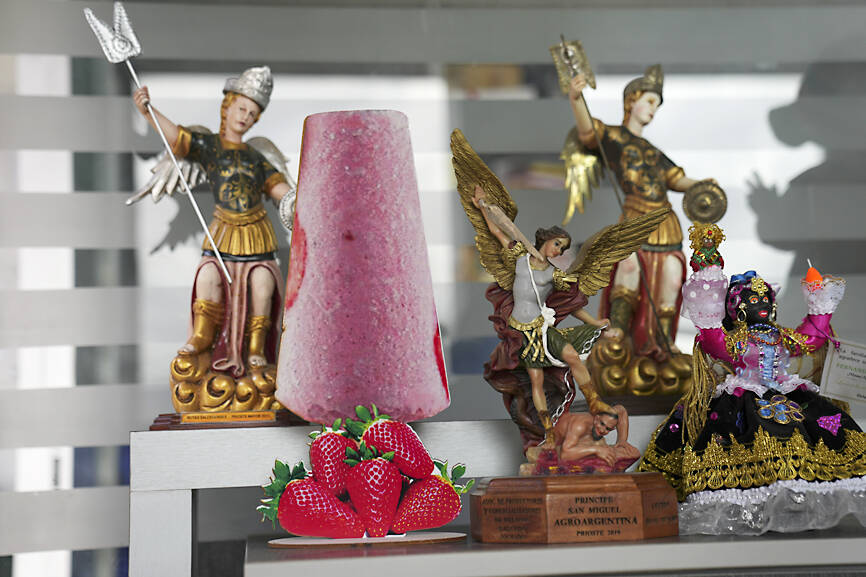Ice-cream production in Salcedo, a quaint town in Ecuador’s central highlands, began in the middle of the 20th century, born from the ingenuity of Franciscan nuns.
Locals say the sisters would drink fruit shakes made with milk from the region’s dairy farms until one of them began collecting the leftovers and turning them into creamy popsicles that became an overnight sensation.
The nuns sold the popsicles in town to gather funds for poor people, but the people of Salcedo saw a business opportunity and began experimenting with new flavors and techniques, establishing a thriving popsicle industry that has made their small town famous among ice-cream lovers.

Photo: AP
However, a recent wave of power outages, triggered by a prolonged dry spell, is threatening the future of Salcedo’s ice-cream industry and melting away its dreams of a more prosperous future.
The daily power outages, which began earlier this year and intensified in September, can last up to 14 hours. They have come about due to drier-than-usual weather in Ecuador, which relies heavily on hydroelectric plants. During most months of the year, hydroelectric plants produce 70 to 90 percent of Ecuador’s electricity. The nation of 17 million people invested heavily in dams over the past two decades, but it is now struggling to come up with alternatives.
“We are living through the worst third-world conditions,” said Gabriel Pumasunta, owner of the Polar Bear ice-cream factory. “We’re plunged into darkness.”

Photo: AP
Pumasunta, who runs the small company with his two brothers, said that if the power outages continue this month, they will have no choice but to shut down the plant.
“We will have to work elsewhere,” he said.
Pumasunta said that power outages have halted production and storage, causing much of his product to melt.

Photo: AP
Before outages intensified in September, Polar Bear was producing 60,000 popsicles per month, Salcedo said.
Now, the small company makes 10,000 popsicles per month, and it has been forced to let go of eight of its 10 employees.
To stay afloat, Pumasunta has dipped into the company’s savings and those of his family. He now works on the plant’s machines himself, taking care of deliveries to bring down costs, while his parents have also stepped up to help.
Ecuadoran President Daniel Noboa, who was elected last year in a special election that followed the resignation of Ecuador’s previous president, has not been able to solve the electricity crisis.
The chamber of commerce in Guayaquil, Ecuador’s largest city, estimates that power outages are generating weekly losses of US$700 million for Ecuadorian businesses.
German Soria, president of the association of artisanal ice-cream makers, said that before the power crisis, Salcedo had 80 small and medium-sized ice-cream plants, and three large factories. Now, 30 of these smaller plants have been forced to close.
Soria’s own ice-cream plant, which is in a shed behind his house, now sits empty.
He said he stopped production three weeks ago and has been forced to sell some equipment, as well as a plot of land to cover his debts.
He said that the outages, which occur at unexpected times, make it hard to plan production.
“Our clients are also less keen to buy ice-cream, because they’re not sure if they can keep the popsicles from melting,” he said.
According to local officials, the power crisis has cost 300 jobs in Salcedo, a town renowned for its fruit-flavored ice-cream, including flavors such as blackberry and taxo, an aromatic and somewhat acidic fruit that resembles passion fruit.
Noboa has promised that power shortages in Ecuador will end this month, but analysts doubt his claim, saying the country lacks the capacity to make up for a 1,900-megawatt deficit.
The Ecuadoran government has bought and rented dozens of large electric generators that are expected to arrive in the following weeks, but as Marco Acuna, the president of Ecuador’s national guild of engineers, said: “They do not have the capacity to make up for the current deficit.”
Meanwhile, in Salcedo, the collapse of the local ice-cream industry has rippled through the local economy, affecting dairy farms, fruit growers, transporters and mom-and-pop stores that specialized in selling the famous popsicles.
“Before [the power cuts] we would buy up to 150 popsicles a day,” said Maria Juliette Lopez, who owns a small shop on the Panamerican highway where tourists and truck drivers stop to buy snacks.
“Now we can only take up to 40 popsicles a day, because any product that is left over will melt” when her freezer stops working, she said.
While the power outages appear to be hitting small and medium-sized producers and vendors the most, Salcedo’s three largest ice-cream factories say they have also been affected.
One of those is Corp Ice-Cream, whose factory used to buzz with activity at noon, with its 35 employees working hard to produce up to 20,000 popsicles per day.
However, during a recent visit to the plant, there was only one employee sweeping in the dark, due to the lack of power.
Paco Hinojosa, the company’s manager, said Corp Ice Cream stayed afloat thanks to its customers in the US, who order 120,000 popsicles per month during the summer.
However, the winter months bring a halt to US exports, which will not resume until about March.
Corp Ice Cream’s sales in Ecuador have gone down by 40 percent since the power outages began in the middle of September and that is taking a toll on its suppliers.
“We used to buy 2,500 liters of milk and 160 liters of cream each day,” Hinojosa said. “Now we have cut down our orders by half — and the same goes for fruit.”
Next to his desk, Hinojosa has a small altar to Saint Michael the Archangel, the city’s patron saint, whom he has been asking for health — and more rain.
“It brings tears to your eyes to see this factory paralyzed due to the lack of electricity,” he said.

The US dollar was trading at NT$29.7 at 10am today on the Taipei Foreign Exchange, as the New Taiwan dollar gained NT$1.364 from the previous close last week. The NT dollar continued to rise today, after surging 3.07 percent on Friday. After opening at NT$30.91, the NT dollar gained more than NT$1 in just 15 minutes, briefly passing the NT$30 mark. Before the US Department of the Treasury's semi-annual currency report came out, expectations that the NT dollar would keep rising were already building. The NT dollar on Friday closed at NT$31.064, up by NT$0.953 — a 3.07 percent single-day gain. Today,

‘SHORT TERM’: The local currency would likely remain strong in the near term, driven by anticipated US trade pressure, capital inflows and expectations of a US Fed rate cut The US dollar is expected to fall below NT$30 in the near term, as traders anticipate increased pressure from Washington for Taiwan to allow the New Taiwan dollar to appreciate, Cathay United Bank (國泰世華銀行) chief economist Lin Chi-chao (林啟超) said. Following a sharp drop in the greenback against the NT dollar on Friday, Lin told the Central News Agency that the local currency is likely to remain strong in the short term, driven in part by market psychology surrounding anticipated US policy pressure. On Friday, the US dollar fell NT$0.953, or 3.07 percent, closing at NT$31.064 — its lowest level since Jan.

The New Taiwan dollar and Taiwanese stocks surged on signs that trade tensions between the world’s top two economies might start easing and as US tech earnings boosted the outlook of the nation’s semiconductor exports. The NT dollar strengthened as much as 3.8 percent versus the US dollar to 30.815, the biggest intraday gain since January 2011, closing at NT$31.064. The benchmark TAIEX jumped 2.73 percent to outperform the region’s equity gauges. Outlook for global trade improved after China said it is assessing possible trade talks with the US, providing a boost for the nation’s currency and shares. As the NT dollar

The Financial Supervisory Commission (FSC) yesterday met with some of the nation’s largest insurance companies as a skyrocketing New Taiwan dollar piles pressure on their hundreds of billions of dollars in US bond investments. The commission has asked some life insurance firms, among the biggest Asian holders of US debt, to discuss how the rapidly strengthening NT dollar has impacted their operations, people familiar with the matter said. The meeting took place as the NT dollar jumped as much as 5 percent yesterday, its biggest intraday gain in more than three decades. The local currency surged as exporters rushed to